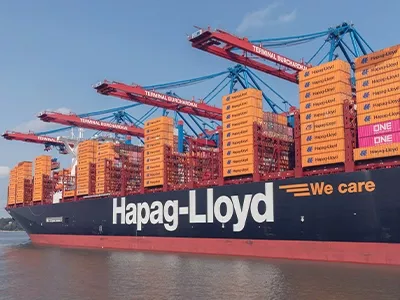
Integrated Financial and Operational Planning at Hapag-Lloyd
Creating a driver-based connection between capacity, sales, and costs to enable a collaborative approach across 400 planners

As one of the world's leading logistics companies, Hapag-Lloyd's operational processes are extremely complex, requiring transparency and collaboration amongst various teams. Board has enabled the business to gain complete visibility of its operations and move towards fully integrated financial planning across a team of 400 planners that perfectly links sales, capacity, and cost planning in a driver-based approach.
- Industry: Transportation & Logistics
- Department: Finance, Sales, Supply chain
- Container Ships: 235
- Employees: 12,800
- Countries: 128
In partnership with:

With 235 modern container ships, a transport volume of 11.9 million TEUs (standard containers) per year, around 12,800 employees in 399 offices across 128 countries, and headquarters in Hamburg, Hapag-Lloyd is one of the world’s leading liner shipping companies.
The company’s fleet has a total capacity of 1.6 million TEUs and its container stock, of around 2.5 million TEUs, features one of the largest and most modern collections of refrigerated shipping containers of any shipping provider.
The Challenge: Making complexity more manageable
Each year, 119 of Hapag-Lloyd’s own ships, plus a similar number of chartered vessels, transport almost 12 million containers to more than 600 different ports. Add to this the coordination of the corresponding feeder and pick-up traffic over land and the complexity of the challenges faced by the 400 staff involved in planning at Hapag-Lloyd is clear.
Managing logistics on this scale requires a perfectly coordinated planning process. The basis for this is an annual bottom-up planning activity, which also inputs into a strategic five-year plan due to capital requirements. This basic process takes about three months and is supplemented three times a year by budget and forecast planning. There is also a monthly update to account for short-term trends.
The process starts with operational planning, followed by sales planning which is supported by driver-based cost planning. At the end of this process comes financial planning and analysis (FP&A), which involves sending Excel sheets to as many as 128 countries around the world. Merle Remmel, Director of Controlling at Hapag-Lloyd, explains the challenges associated with this process:
The consolidation of this data is very time-consuming and labor-intensive, especially since not all employees send back the Excel files in the specified formats and templates, meaning they must be reworked manually.
As part of a digitalization initiative at Hapag-Lloyd, the need to introduce a system that would perfectly support employees in these complex planning activities and accelerate the entire planning process was identified. A project team was put together, which, together with key stakeholders and experts from celver AG, analyzed the existing planning process to determine what was essential to maintain and which areas could be optimized and improved with the support of an appropriate system.
The team worked out which points in the planning process were causing the biggest problems and at the same time defined its direction to ensure future requirements would be met. This resulted in the following project goals:
- Increase the level of automation and flexibility
- Retain driver-based planning capabilities to enable adjustments to be made with ease and to reliably calculate the resulting outcomes of these adjustments
- Keep the number of employees involved in the planning process the same, based on their importance in ensuring buy-in and commitment to the agreed plan
- Updates to planning based on short-term trends should, if possible, be rebuilt into a rolling forecast to enable the estimation, at any time, of what the financial outcomes will be at the end of the year
The Board Solution: High compatibility with upstream and downstream systems
Thereafter, the project team dealt with the selection of an appropriate system, exploring the Business Intelligence market, solutions already used in the company, and speaking with experts. Hapag-Lloyd carried out small pilot projects with eligible vendors and the best solutions were subsequently examined through a proof-of-concept. The providers were then compared in a rating matrix and presented to the management team, who jointly selected the future Business Intelligence system – Board. Merle highlights why the decision was made:
In addition to industry expertise and an excellent analyst ranking, Board was capable of being integrated very well into the existing system landscape.
Once implemented, the benefits of Board in bringing together data from across the business were soon realized, as Mathias Schäfer, Senior Director IT at Hapag-Lloyd, explains:
The upstream systems that provide the raw data are SAP and proprietary systems from Hapag-Lloyd. Board links the data of both systems via SQL Server and forms a single-point-of-truth (SPOT) for the planners worldwide.
In addition, the Board SAP Connector, which ensures a proven and secure connection to the SAP data, is used for some data provision. Both the headquarters and the regions can access the same accurate, reliable data. The worldwide Controlling and Sales teams can view it directly in Board, add their own data as required, and partial extracts can be exported from Board to Excel by simply pressing a button. This enables employees to use and share data in the known system while ensuring the consistency and transparency of the data is maintained.
When implementing the system, in addition to the flexibility and ease of use of Board, its short development times came to fruition. Together with celver AG as the implementation partner, the project team has already created and rolled out more than 20 planning masks with Hapag-Lloyd‘s look and feel, despite the tight schedule and extensive requirements of the project in the first six months.
Mirko Schömann from celver AG discusses the project:
The challenges were very complex. Linking and processing data from different feeder systems with different structures in such a way that they fit together and are comparable was a real mammoth task. The high level of detail of the planning process and the large number of departments and planners involved added another level of complexity.
In the end, the excellent cooperation between the Hapag-Lloyd project team, celver AG, and Board made a huge contribution to the timely release of the large planning application.
Customer Benefits: Perfectly linked Capacity, Sales, and Cost Planning
Henrik Schilling, Managing Director Controlling at Hapag-Lloyd, provides more detail about the planning process:
About 50 capacity planners, 200 sales planners, and 150 cost planners are working on the complex planning activities at Hapag-Lloyd. Of course, their plan sizes are very different. That's why the trade manager, who plans the capacities, needs to know which orders are required to optimally plan routes and capacities.
This creates a very complex voting system between sales planners and trade managers, but since both groups now always have the same reliable data in Board, the voting process has been considerably simplified. In addition, the system allows users to drill down to individual routes for detailed analysis.
Driver-based cost planning is also linked to sales planning with raw data coming from the SAP system. All cost aspects such as container type, cooling, geo-hierarchy, or contract type are recorded and directly linked to the container quantities. Here, too, drilling down to the detailed information offers maximum transparency for the planners, as Henrik highlights:
Today we can automatically calculate an exact price based on the number of containers and the cost per unit, so do not have to resort to average costs.
Board has also delivered several other benefits, meeting the goals defined at the beginning of the digitalization process. The lead time of the individual planning steps has been significantly reduced, as has the workload for the individual employees. This in turn contributes to the continued strong buy-in of employees. The new system makes it possible to automate repetitive tasks and steps to a greater extent and still create greater flexibility, while the introduction of the rolling forecast helps to keep the end of year results in focus at all times.
Merle summarizes the project's status:
In this first implementation phase the focus was on planning. In the next phases, we will also look more closely at the topics of reporting and dashboarding. For example, we want to implement financial reporting with the integrated commenting functionality. For management, we plan the creation of dashboards and the mapping of current KPIs directly on screens, tablets, and smartphones.
When asked what he takes from the initial project as a 'Lesson Learned', Mirko has a clear answer:
It is very important to involve the departments in a timely and comprehensive manner and, above all, to include them in the design of the planning logic and screens. This avoids many change requests and speeds up implementation considerably.
With this project, Hapag-Lloyd has begun its journey to reposition Finance and Controlling within the company. For the medium-term controlling strategy, the company has defined three clear messages:
- Pace over perfection
- Everyone on board
- 90-day heartbeat
It is the departure to new a new world, in which “everyone on board” means, quite literally, just that.






